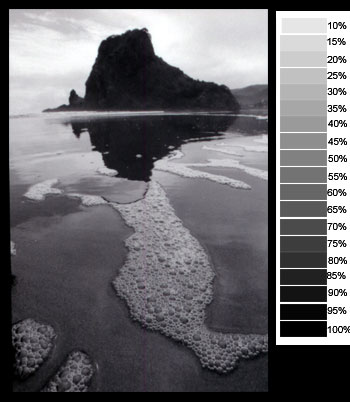Sequence viewing > Index - Copying Techniques - Resource - ©
Lloyd Godman
Copying
Colour works
While
all the principles for copying a B&W continuous tone image apply to
colour there is also the issues of recording accurate colour .

BST
14
Colour and Grey charts #14 (analogue to Kodak Q14)
Offset printed colour chart plus sikl-screened grey step wedge (20 steps,
1:80 contrast).
Size: 76x356 mm.

When
working with colour, it is also a wise strategy to include a grey scale
step wedge with the image being copied.
Like the inclusion of a grayscale step wedge along side the B&W image
to act as a known reference point, a colour separation or colour patch
chart is photographed along side the colour original. These charts are
printed with standard know colours that can be followed through a range
of reproductive process like off set printing etc. And usually we photograph them along side the work - this way the exact
colour can be matched as the work goes through the various stages of reproduction. • Use a greyscale
in the image to calibrate your tones. Photograph this alongside the image
as a known tonal reference point. A step wedge is a tonal scale from white
though grey to white, manufactured by companies like Agfa and Kodak. The
wedge or tonal scale is photographed along side the work as an accurate
reference as to the tones of an image. Say the image was a black and white
painting but it was predominately black with little white. In the reproduction
of the work, it becomes difficult to work out exactly where true black
is and where the intermediate grey tones fall. The set wedge acts a known
reference point.


Want to learn more? - do a workshop or one on one with Lloyd Godman
|